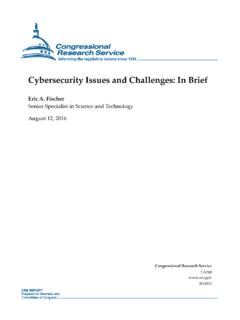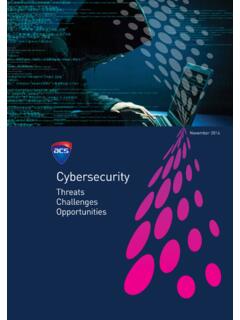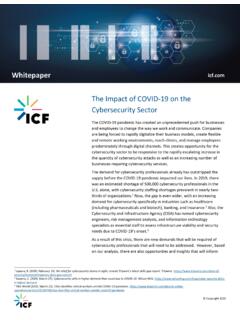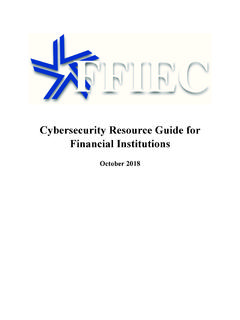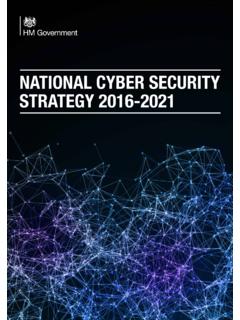Transcription of The 2018 SANS Industrial IoT Security Survey
1 A SANS Survey The 2018 SANS Industrial IoT. Security Survey : Shaping IIoT Security Concerns Written by Barbara Filkins Sponsored by: Advisor: Doug Wylie ForeScout Technologies, Inc. July 2018. SANS Analyst Program 2018 SANS Institute Foreword by IIC. The world is evolving toward a future that is built upon smart systems composed of disparate types of things including cyber/physical systems, embedded systems, Industrial control systems, connected medical devices, connected cars and smart everything, and this trend cannot be stopped. However, to realize this future, industries must properly integrate the connected, software-enabled, real-world interactive types of devices and systems that we call the Industrial Internet of Things (IIoT) into a cohesive system. Unfortunately, along with the promise of greater technical capabilities and business opportunities comes increased complexity, and in turn, a higher vulnerability to cyber Security threats that may upset the entire applecart.
2 However, IIoT Security cannot be considered in isolation, but rather as part of the system characteristics that must support the safety, reliability, resilience and privacy expectations that can be described as the trustworthiness of the system. The trustworthiness must also contend with the culture clash between the convergence of information technology and operational technology that is presenting both challenges and opportunities for organizations and the industries that support and supply them. To help address these challenges , the Industrial Internet Consortium (IIC)1 was created in 2014 to pave the way for realizing the business value in IIoT and address the risks that emerge, affecting those that use, operate or live in proximity to those IIoT systems. This report provides much-needed insights and validation into the real problems faced today and what is working to address them. It provides useful input to many, including the IIC.
3 And its partners across the globe, where the concerns related to Security are not only being addressed, but also being addressed as part of the holistic need for trustworthy IIoT systems. Industrial Internet Consortium Foreword by ARC. The digital transformation of industry, infrastructure and cities has clearly begun. Whether it's called Industrial Internet of Things (IIoT), Industry or digitalization, companies are developing new business improvement strategies based on analytics, artificial intelligence (AI) and machine learning. These efforts are widespread and far- reaching. They will affect every critical activity including operations, maintenance and engineering. Information technology (IT), operational technology (OT) and engineering technology (ET) will all be affected by the explosion in sensors, new networking solutions and architectural changes. Smart organizations understand the urgency of building a cybersecurity plan that supports these programs.
4 New strategies need to be in place before business leaders demand widespread deployment. Expecting them to wait for Security is na ve; the cost 1. Industrial Internet Security Framework (IISF) Technical Report, Chapters 2 - 4, September 2016, SANS Analyst Program | The 2018 SANS Industrial IoT Security Survey : Shaping IIoT Security Concerns 2. and performance benefits are simply too large to ignore, and competition is forcing rapid adoption. These IIoT efforts will invariably lead to violations of implicit cyber Security assumptions, including well-defined perimeters and architectures, which need to be addressed. Understanding how peers are dealing with these challenges will help you accelerate development of a resilient, IT-OT-IIoT cyber Security program. The findings of this SANS research align quite well with ongoing feedback ARC receives from end users in process industries, discrete manufacturing and infrastructure. Predictive maintenance and operational improvements are the primary focus of most of their IIoT efforts.
5 Both involve broad-based connection of existing and new plant sensors with cloud-based solutions and service providers. Cloud connectivity is a concern, but most companies believe they can deal with this through network segmentation and isolation of control networks. The Security of new endpoints is clearly more troublesome. Few organizations believe they can rely on the sensors' original equipment manufacturers (OEMs) in this emerging market to provide secure devices. Lack of control over development processes and complex supply chains aggravates end user concerns. Managing endpoint Security updates and patches is another daunting challenge. Plant staffs are already overwhelmed with Security hygiene tasks for existing assets. There is no bandwidth for coordinating Security patches from a multitude of different OEMs. Likewise, few plants have the kind of secure remote access needed to enable direct management by the OEMs. Not surprisingly, these endpoint Security concerns are driving increased support for standards groups such as the Industrial Internet Consortium (IIC) and device-certification programs offered by groups such as the International Society of Automation (ISA) and Underwriters Laboratories (UL).
6 Sid Snitkin, PhD. Vice-President, cybersecurity Services ARC Advisory Group Executive Summary The term IoT broadly refers to the connection of devices other than the typical computational platforms (workstations, tablets and smartphones) to the Internet. IoT. encompasses the universe of connected physical devices, vehicles, home appliances and consumer electronics essentially any object with embedded electronics, software, sensors, actuators and communications capabilities that enable it to connect and exchange data. Within this universe, Industrial IoT (IIoT) focuses specifically on Industrial applications that are often associated with critical infrastructure, including electricity, manufacturing, oil and gas, agriculture, mining, water, transportation and healthcare. IIoT, like the ISA/IEC-624432 zone and conduit concept model before it, has broken the rules of traditional, mainly physically and functionally separated network system architectures, as recommended by the Purdue Enterprise Reference Architecture (PERA).
7 Since the Endpoint devices can, and often do, now connect directly to Internet, either individually or as part of an IIoT system. 2. 3. SANS Analyst Program | The 2018 SANS Industrial IoT Security Survey : Shaping IIoT Security Concerns 3. This growth will continue. Most organizations in this Survey envision a 10 to 25% growth Reshaping Industrial Controls in their connected devices for the foreseeable future, a growth rate that will cause the systems to which IIoT devices connect to double in size roughly every three to seven years. 32%. In its 2017 Roundup of Internet of Things Forecasts, Forbes reports that the installed base of IIoT devices connect of IoT devices is forecast to triple in the next seven years (from in 2018 to directly to Internet, in 2025), with manufacturing accounting for 84% of this growth in the past IPv6 bypassing traditional IT. can enable the needed expansion of the Internet's address space to accommodate this Security layers.
8 Growth, but business drivers also demand corresponding advancements into increased visibility, efficiency, Security and control over these connected assets. 72%. The Security of the IIoT endpoints is the leading concern for respondents to the 2018 rely on IP suites to control, SANS IIoT Security Survey , with network Security controls and countermeasures currently configure and collect data from devices. being the main enablers of IIoT Security . Most of the growth for connected devices is expected to be for those used for monitoring, status, alarms and alerting, as well as predictive maintenance, but over 50% of respondents are still using their devices 71%. for directly controlling operations and processes. As IIoT moves Industrial operations increasingly toward distributed, online processes, increased visibility at the endpoint of devices are already used for monitoring needs to supplement today's reliance on the collection and analysis of network traffic (process health, and Security events for incident response and remediation.)
9 Condition monitoring). Securing an organization's IIoT infrastructure requires understanding the threats and risks to be faced. According to the Survey data, over the next two years, the leading 41%. threats pertain to IIoT life-cycle management issues and human error, while the top collect specific Security and reported risk is related to Security considerations in product and system installation, operations data about IIoT. devices and systems. configuration, service, support and maintenance. One way to interpret this is that attackers will capitalize on vulnerabilities inherent in the products, or weaknesses introduced by those responsible for building, operating and maintaining the systems where these devices are in use, not unlike what we see in other network systems. In most Industrial settings, when organizations need to make a choice between ongoing operations and Security , it is rare for Security to take priority.
10 Confidence in how well organizations are able to secure their IIoT environments, however, depends on who has been assigned to manage IIoT risk. The closer someone is Key Findings to the IIoT systems, the greater the recognition of a challenging reality. The individuals C. onfusion over what is meant probably the most knowledgeable about IIoT implementation, the OT team, appear the by endpoint further highlights the need for a reference least confident in their organization's ability to secure these devices, while company architecture unique to IIoT. leadership and management, including department managers, appear the most assured. E. ndpoints are the concern;. Convergence in IIoT is not just about technology; it's about who manages the risk and networks are the current defines the budget. For many, such organizational disparities make Security budgeting, control. staffing and training decisions all the more difficult to execute.

